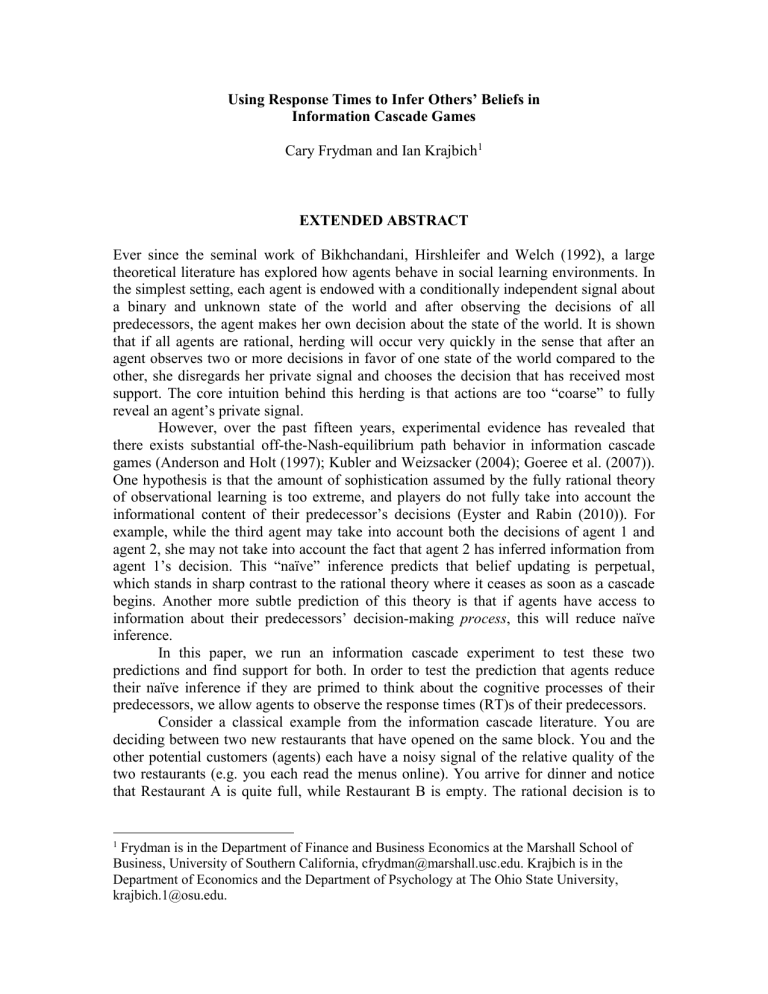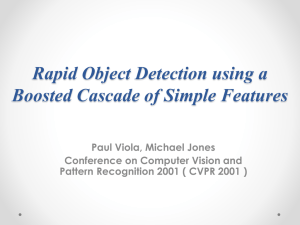- Stanford Institute for Theoretical Economics

Using Response Times to Infer Others’ Beliefs in
Information Cascade Games
Cary Frydman and Ian Krajbich
1
EXTENDED ABSTRACT
Ever since the seminal work of Bikhchandani, Hirshleifer and Welch (1992), a large theoretical literature has explored how agents behave in social learning environments. In the simplest setting, each agent is endowed with a conditionally independent signal about a binary and unknown state of the world and after observing the decisions of all predecessors, the agent makes her own decision about the state of the world. It is shown that if all agents are rational, herding will occur very quickly in the sense that after an agent observes two or more decisions in favor of one state of the world compared to the other, she disregards her private signal and chooses the decision that has received most support. The core intuition behind this herding is that actions are too “coarse” to fully reveal an agent’s private signal.
However, over the past fifteen years, experimental evidence has revealed that there exists substantial off-the-Nash-equilibrium path behavior in information cascade games (Anderson and Holt (1997); Kubler and Weizsacker (2004); Goeree et al. (2007)).
One hypothesis is that the amount of sophistication assumed by the fully rational theory of observational learning is too extreme, and players do not fully take into account the informational content of their predecessor’s decisions (Eyster and Rabin (2010)). For example, while the third agent may take into account both the decisions of agent 1 and agent 2, she may not take into account the fact that agent 2 has inferred information from agent 1’s decision. This “naïve” inference predicts that belief updating is perpetual, which stands in sharp contrast to the rational theory where it ceases as soon as a cascade begins. Another more subtle prediction of this theory is that if agents have access to information about their predecessors’ decision-making process , this will reduce naïve inference.
In this paper, we run an information cascade experiment to test these two predictions and find support for both. In order to test the prediction that agents reduce their naïve inference if they are primed to think about the cognitive processes of their predecessors, we allow agents to observe the response times (RT)s of their predecessors.
Consider a classical example from the information cascade literature. You are deciding between two new restaurants that have opened on the same block. You and the other potential customers (agents) each have a noisy signal of the relative quality of the two restaurants (e.g. you each read the menus online). You arrive for dinner and notice that Restaurant A is quite full, while Restaurant B is empty. The rational decision is to
1 Frydman is in the Department of Finance and Business Economics at the Marshall School of
Business, University of Southern California, cfrydman@marshall.usc.edu. Krajbich is in the
Department of Economics and the Department of Psychology at The Ohio State University, krajbich.1@osu.edu.
choose Restaurant A, regardless of your signal (assuming enough noise in the signal technology).
Now suppose instead that you arrive earlier in the evening and thus are able to observe the other agents making their decisions. After the first two agents line up in front of A, you notice that all the subsequent agents hesitate before choosing A, as evidenced by longer decisions. This hesitation can only mean one thing: those agents received private signals favoring B, creating conflict between private and public information.
Based on this information you wisely choose B, despite the fact that all the other agents have chosen A.
This example is motivated by a vast literature in psychology and neuroscience
(dating back at least to Henmon (1906)) showing that RTs are informative about decision conflict (Krajbich, Oud, Fehr (2014)). However, the usefulness of RT data in strategic situations has not been studied. Here, using a within-subjects design, we run an experiment using the same parameters as the classic Anderson and Holt (1997) experiment, but with a novel “RT” treatment. In this RT treatment we display the RT of each agent in addition to her decision.
Results
Our main results are as follows. First, we show that both RTs and decisions are well explained by a standard model of the decision process (Figures 1 and 2), the driftdiffusion model (DDM) (Ratcliff (1978)). Specifically, we show that RTs are longest for the most difficult decisions (when previous decisions exhibit highest conflict with an agent’s private signal) and are shortest for the easiest decisions (when there is no conflict between public information and private signal.) We then use the RT data to show that belief updating persists beyond the rational bounds, which is consistent with the naïve inference model. More specifically we find that, conditional on choosing with one’s signal, RT decreases with the net number of preceding decisions that align with the signal. Similarly, conditional on choosing against one’s signal, RT decreases with the net number of preceding decisions that go against the signal. In both cases we see a continuing decrease in response time beyond a net value of two, which indicates that subjects find choices within a cascade informative (contrary to the fully rational theory).
Second, after demonstrating that RTs carry information, we demonstrate that subjects use this information in making their decisions. Specifically, on trials where an agent’s signal conflicts with her predecessor’s decision, we show that an agent is significantly more likely to choose with her signal when her predecessor exhibits a long
RT. This suggests than an agent may discount her predecessor’s decision if it is accompanied by a long RT. This result is consistent with predictions from the DDM that longer RTs are associated with more conflicted, and thus less confident decisions.
Conclusions
Our results contrast with recent theory that interprets long RTs as indicative of contemplative decisions (Eliaz and Rubinstein (2014)). If this were the case, a subject should be more likely to follow a predecessor that has taken a long amount of time to decide, as the long RT is a sign of a contemplative decision. Instead we observe the opposite result, as subjects are less likely to follow a predecessor who exhibits a long RT.
More generally, our results imply that RTs can be used by both the econometrician and players within the game to infer the beliefs of other players. Thus in economic environments where RT is observable, agents may be able to extract full information, alleviating concerns about herding.
References
Anderson, Lisa R., and Charles A. Holt. "Information cascades in the laboratory." American Economic
Review 87.5 (1997): 847-862.
Bikhchandani, Sushil, David Hirshleifer, and Ivo Welch. "A theory of fads, fashion, custom, and cultural change as informational cascades." Journal of Political Economy 100.5 (1992): 992-1026.
Eliaz, Kfir, and Ariel Rubinstein. “A model of boundedly rational “neuro” agents” Economic Theory 57
(2014): 515-528.
Eyster, Erik, and Matthew Rabin. "Naive herding in rich-information settings." American Economic
Journal: Microeconomics 2.4 (2010): 221-243.
Goeree, Jacob, Tom Palfrey, Brian Rogers, and Richard McKelvey. "Self-correcting information cascades."
The Review of Economic Studies 74.3 (2007): 733-762.
Henmon, Vivian Allen Charles. The time of perception as a measure of differences in sensations . No. 8.
Science Press, 1906.
Krajbich, Ian, Bastiaan Oud, and Ernst Fehr. “Benefits of Neuroeconomic Modeling: New Policy
Interventions and Predictors of Preference” American Economic Review: Papers & Proceedings 104.5
(2014): 501-506.
Kübler, Dorothea, and Georg Weizsäcker. "Limited depth of reasoning and failure of cascade formation in the laboratory." The Review of Economic Studies 71.2 (2004): 425-441.
Ratcliff, Roger. "A theory of memory retrieval." Psychological Review 85.2 (1978): 59-108.
100%
90%
80%
70%
60%
50%
40%
30%
20%
10%
0%
-8 -6 -4 -2 0 2 4 6 8
Net # of Previous Decisions that Agree with Private Signal
Figure 1: Probability of choosing with private signal increases with number of previous decisions that agree with private signal. Note that indifference occurs when a subject faces a net two previous decisions conflicting with her private signal.
Data is taken from N=1,440 decisions over the course of three experimental sessions consisting of 48 subjects.
6000
Choose Against Signal
5000
Choose With Signal
4000
3000
2000
1000
0
-7 -6 -5 -4 -3 -2 -1 0 1 2 3 4 5 6 7
Net # of Previous Decisions that Agree with Private Signal
Figure 2: Response times are consistent with the predictions of the drift diffusion model. For trials in which subjects chose against their signal (red), RTs increase as the net number of previous decisions in favor of their signal increases. For trials in which subjects chose with their signal (blue), RTs decrease as the net number of previous decisions in favor of their signal increases. Note that if we average over these two sets of data, the highest mean RT occurs at indifference (see Fig. 1).
Data is taken from N=1,440 decisions over the course of three experimental sessions consisting of 48 subjects. Data is shown if there are more than 10 observations for the condition.











